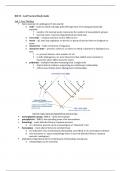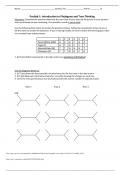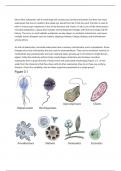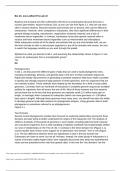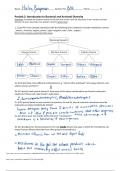University Of California - Davis
Latest uploads at University Of California - Davis. Looking for notes at University Of California - Davis? We have lots of notes, study guides and study notes available for your school.
-
321
- 0
-
23
All courses for University Of California - Davis
Latest notes & summaries University Of California - Davis
BIS 2C Postlab 3: Body Form in Naegleria Across Environments (Graded A+)
BIS 2C Postlab 7: Introduction to Metazoa (Graded A+)
BIS 2C Pre-Lab 7: Introduction to Metazoa (Graded A+)
BIS 2C – Lab Practical Study Guide (Updated and Verified)
Postlab 1: Introduction to Phylogeny and Tree-Thinking Directions: Complete the questions below by the start time of your next lab. Be precise in your answers and pay attention to your reasoning. Your postlab is worth 5 points total. Use the following data matrix to answer the questions below. Follow the conventions shown to you in lab this week to answer the questions. If you’re having trouble, be sure to watch the learning glass video on unrooted trees and parsimony. 1 2 3 4 5 6 Great...
Most often, eukaryotes call to mind large and conspicuous animals and plants, but there are many eukaryotes that are not visible to the naked eye. Recall from lab 2 that the word ‘microbe’ is used to refer to microscopic organisms in any of the domains and viruses. In lab 3, you will be introduced to microbial eukaryotes, a group that includes several disparate lineages with diverse ecology and life history. The occur in most habitats worldwide, are key players in symbiotic interactions,...
Bacteria and Archaea are often collectively referred to as prokaryotes because they lack a nucleus (pro=before, karyon=nucleus). But, as you can see from figure 2.1, they are not each other’s closest relatives. Because bacteria and archaea are so diverse, they can be difficult to characterize. However, when compared to eukaryotes, they have significant differences in their general biology including, reproduction, organization of genetic material, and a lack of membrane-bound organelles. I...
Postlab 2: Introduction to Bacterial and Archaeal Diversity Directions: Complete the questions below by the start time of your next lab. Be precise in your answers and pay attention to your reasoning. Your postlab is worth 5 points total. 1. (1 pts) Fill in the concept map below with the following terms related to microbe metabolism: chemo- , hetero-, chemical, organic, photo-, light, inorganic, auto-, litho-, organo-. Some terms may be used more than once. 2a. (0.25 pts) How many differen...
Pre-lab 6: Botanical Conservatory and Fungal Diversity (Score: 4.75/5) Question 1. Identify two reasons why maintaining a large, living plant collection is an important public and scientific resource. It lets us study different types of plants without having to travel all over the world and it teaches us better methods of conservation. Question 2. In figure 6.2 above, which season (X or Y) would correspond to winter at point A? Season X Question 3. On which side (left or right) of figure...
Pre-lab 5: Introduction to Plant Diversity II Question 1. In contrast to Bryophytes, Lycophytes, and Monilophytes what specific advantage does pollen provide to seed plants in terms of their reproductive biology? Pollen is advantageous because it does not need water for the male cell to reach the female cell. Instead, pollinators transfer the different cells. Question 2. In contrast to Bryophytes, Lycophytes, and Monilophytes what specific advantage do seeds provide to seed plants in terms...




